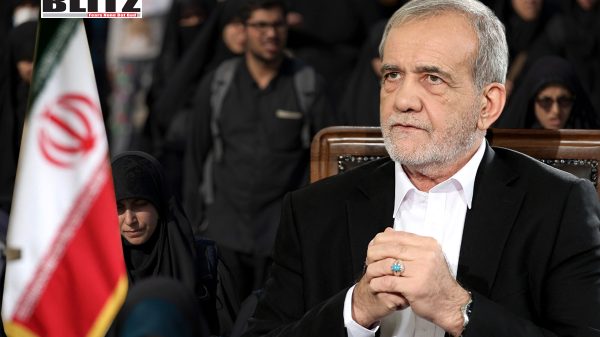Iran President criticizes controversial new hijab law
- Update Time : Wednesday, December 4, 2024

Iran’s President Masoud Pezeshkian has raised significant concerns regarding the newly passed “hijab and chastity” law, which would impose stricter penalties on women who defy the country’s mandatory hijab regulations. As the law waits for the president’s approval on December 13 to become official, Pezeshkian’s remarks underscore the deepening divide between government policies and a growing segment of the Iranian public, particularly women who have increasingly resisted the hijab mandate.
Since the 1979 Islamic Revolution, Iran has mandated that women must cover their hair and wear modest clothing in public as part of the country’s strict interpretation of Islamic law. However, in recent years, defiance against this regulation has been growing. Public protests, particularly following the death of Mahsa Amini in September 2022, have sparked a larger movement against the government’s enforcement of the hijab. Amini, a 22-year-old Kurdish woman, was arrested by the morality police for allegedly violating the dress code, and her subsequent death in police custody ignited widespread protests across the nation. These protests have led to a significant shift in Iranian society, with many women publicly rejecting the hijab and demanding greater freedoms.
The protests sparked by Amini’s death continue to resonate in Iran, as more women, particularly in urban areas, defy the hijab law. Social media platforms have become central in the movement, with women posting videos of themselves walking in public without the hijab, symbolizing their rejection of state-imposed morality. This public resistance is not just an expression of individual freedom but is part of a broader demand for greater rights and equality for women in Iran. The defiance of the hijab law has become a symbol of resistance against the authoritarian policies of the Iranian government.
Despite the government’s attempts to suppress these demonstrations, public resistance to the hijab law has only grown stronger. The increasing visibility of women without hijabs in public spaces, along with the widespread dissemination of protest footage on social media, has made it difficult for the regime to ignore the dissent. Yet, in response to this growing defiance, the Iranian government has continued to tighten its grip on dissenters, with lawmakers approving the new “hijab and chastity” law in November 2024.
While the details of the new law have not been officially published, Iranian media outlets have reported that it introduces hefty fines for women who violate the dress code. These fines could amount to up to 20 months’ worth of an average salary for a woman who either improperly wears the hijab or chooses not to wear it at all in public or on social media. If the fines are not paid within 10 days, women face severe consequences, including travel bans and restrictions on accessing public services, such as obtaining a driver’s license or registering for various official permits.
The law represents a severe escalation of the government’s attempts to enforce the hijab mandate, which has already led to widespread alienation among certain sectors of Iranian society. The consequences of this law are far-reaching, with women who defy the dress code risking not just financial penalties but also the erosion of their personal freedoms in various aspects of their lives. These harsh measures are seen as an attempt to curtail the ongoing movement for women’s rights, which has gained momentum following Amini’s death.
Despite the overwhelming approval of the new law by the Iranian Parliament, President Masoud Pezeshkian, who took office in July 2024 after campaigning to dismantle the morality police, has expressed serious reservations about the legislation. Speaking to state television on December 2, Pezeshkian stated, “As the person responsible for promulgating this law, I have many reservations about it.” He also warned that the law could have dangerous consequences for Iranian society, adding that “we risk ruining a lot of things in society because of this law.” Pezeshkian’s remarks signal that the law could deepen the rift between the government and the Iranian public, which has become increasingly disillusioned with the regime’s authoritarian policies.
The president’s concerns reflect the growing opposition within Iranian leadership to policies that risk further alienating the public. Pezeshkian, a moderate politician, has expressed his opposition to the morality police and has been a vocal advocate for greater freedoms, particularly for women. His presidency, which followed years of hardline rule, was seen as a potential shift in the country’s political trajectory. However, his hesitation to sign the new hijab law highlights the delicate balancing act he faces in navigating the deeply entrenched conservative forces within the government while also responding to the desires of a population that increasingly demands change.
The passage of the “hijab and chastity” law and Pezeshkian’s public reservations reflect the complex dynamics within Iranian society. On one hand, the Iranian government seeks to maintain control over public behavior, particularly regarding women’s rights, by enforcing a strict interpretation of Islamic dress codes. On the other hand, there is a clear and growing resistance from segments of the population, particularly younger Iranians, who are seeking greater autonomy over their personal choices.
The new law is likely to exacerbate these tensions, as many women feel that their rights are being trampled upon in favor of state-imposed religious orthodoxy. The increasing number of women appearing in public without hijabs, despite the risk of arrest or punishment, shows that the drive for change is not easily suppressed. The law could provoke further protests, which could destabilize the already fragile relationship between the government and its citizens.
The law also brings into focus the role of the morality police in Iranian society. The morality police were largely responsible for arresting Mahsa Amini, and their actions were a catalyst for the protests that followed. Although the unit has not been officially abolished, it has largely disappeared from the streets in recent months. This shift is seen as a potential acknowledgment by the government that the morality police, with their heavy-handed tactics, have become a symbol of repression and are contributing to the erosion of the regime’s legitimacy.
However, the continuation of restrictive laws, such as the new hijab regulations, suggests that the Iranian government is not yet willing to relinquish its control over women’s bodies and dress codes. The tension between the state’s desire for control and the public’s desire for freedom will likely continue to shape the political landscape in Iran for the foreseeable future.
The approval of the “hijab and chastity” law marks a pivotal moment in the ongoing struggle between the Iranian government and its citizens over issues of personal freedom and state control. While the law represents the government’s attempt to enforce religious orthodoxy, it also risks further alienating a populace that is increasingly resistant to such authoritarian measures. President Pezeshkian’s vocal reservations indicate that there is a growing divide within the leadership, as some officials question the wisdom of policies that could further destabilize the nation. As Iran approaches the December 13 deadline for the law’s implementation, the tensions between the state and society are unlikely to subside anytime soon. The future of the hijab law – and the broader fight for women’s rights in Iran – remains uncertain.
















Leave a Reply